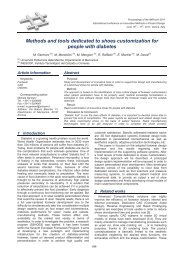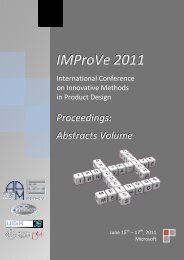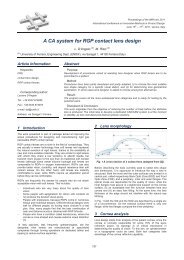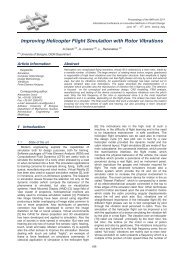IMProVe 2011 - Proceedings
IMProVe 2011 - Proceedings
IMProVe 2011 - Proceedings
Create successful ePaper yourself
Turn your PDF publications into a flip-book with our unique Google optimized e-Paper software.
Geometric Modelling and Analysis<br />
Corresponding Author: Jaime López Soto<br />
Tel.: +34 946014314<br />
Fax.: +34 946014300<br />
e-mail: jaime.lopez@ehu.es<br />
Address: E.U.I.T.I. Bilbao. Plaza La Casilla 3. 48012 Bilbao. Spain.<br />
A parametric associative modelling<br />
of aeronautical structural concepts<br />
under C0, C1 or C2 continuity constraints<br />
V. Dattoma, M. De Giorgi, S. Giancane, P. Manco, A. E. Morabito (a)<br />
(a) Dipartimento di Ingegneria dell’Innovazione - Università del Salento – Lecce, Italy<br />
Abstract:<br />
Purpose:<br />
In this paper, an associative-parametric approach is proposed in order to model the mesh<br />
of an aeronautical concept starting from a set of high-level structural primitives. To assure<br />
orders of continuity higher than C0 between adjacent instances, a suitable mathematical<br />
description of the structural primitives has been identified. The maintenance of the<br />
continuity constraints must be assured when the mesh is modified.<br />
Method:<br />
The Bézier curve and the Coons surface patch, with a suitable degree, are used in order to<br />
assure orders of continuity higher than C0 in the connection points or edges. Appropriate<br />
schemes of dependences are identified to assure the automatic propagation of the<br />
modifications complying with the continuity constraints.<br />
Result:<br />
The approach here proposed allows the designer to carry out the geometric modelling and<br />
the automatic mesh generation within one software environment in a fast and interactive<br />
way and complying with the geometric continuity constraints and the one-to-one<br />
correspondence between the mesh elements. This represents evidently a large advantage<br />
since the structural optimization process is simplified, with a relevant man-hours saving. A<br />
lower number of data transfers between different software is, moreover, involved with<br />
less problems related to the data corruption. Finally low conceptual value operations, due<br />
to manual correction activity of the model, are eliminated.<br />
Discussion & Conclusion:<br />
The methodology here proposed allows the automatic propagation of modifications<br />
satisfying the geometric continuity constraints and the one-to-one correspondence<br />
between the mesh elements. The approach is implemented into a CAD/CAE tool, called<br />
MeshFEM and developed using C++ and Matlab languages and the VTK library for the 3D<br />
graphic visualization.<br />
June 15 th – 17 th , <strong>2011</strong>, Venice, Italy<br />
43<br />
<strong>IMProVe</strong> <strong>2011</strong> - <strong>Proceedings</strong>










